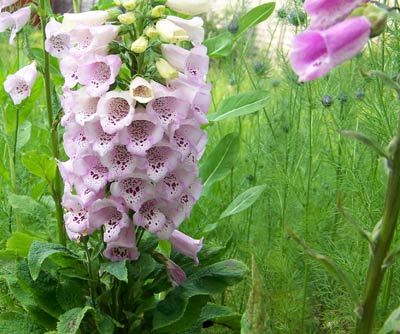Gardeners Tips for Growing Foxgloves -Digitalis
Foxgloves are native to the British isles and can be grown relatively easy here in the UK. They provide an excellent addition to any cottage garden. There distinctive spikes of flowers can be up to 4-5 feet high and they offer a new dimension to any garden. They also attract bees for their extensive nectar.
Foxgloves are poisonous so be careful if you have kids in the garden. The good thing is that slugs don’t seem to like them much either. Parts of the Foxglove are actually used as digoxin a widely used heart drug.
- Foxgloves like full sun, but, also do fine in shade.
- Foxgloves will be fine without extra feeding, but do better with nitrogen rich soils.
- Sowing. As a biennual, Foxgloves need to be sown in May / June. If foxgloves are self sown, the main thing to do is to thin out the seedlings so that they don’t get too crowded. A foot between each plant is a good guide.
- Self sowing. One of the best features of growing foxgloves is that they will usually self sow for the next year. They self seed in moderation and it never becomes invasive. The only gardening might be to thin out the seedlings.
Problems of Growing Foxgloves
One problem of foxgloves is that the tall varieties can get blown over in windy conditions. Try to plant is sheltered spots; they grow well in clumps together.
Varieties of Foxgloves.
The most common variety is D. Purpurea which can be seen growing in British hedgerows. In addition there are cultivated varieties such as ‘Apricot’ and white varieties. There are also dwarf varieties of foxglove such as ‘Temple Bells’ or Primrose carousel’
You can acquire new plants or just admire them as part of a collection
Perennial Foxgloves
Digitalis Grandiflora (yellow foxglove is a hardy perennial flowering foxglove.)

4 thoughts on “Gardeners Tips for Growing Foxgloves -Digitalis”
Thank you for giving information and tips about how to care the plants according to the nature of plants.
beautiful flowers. Always put the plants reflect at the proper sunrises. It takes from sun some food for living that plant. Thank you for giving this information.
Comments are closed.